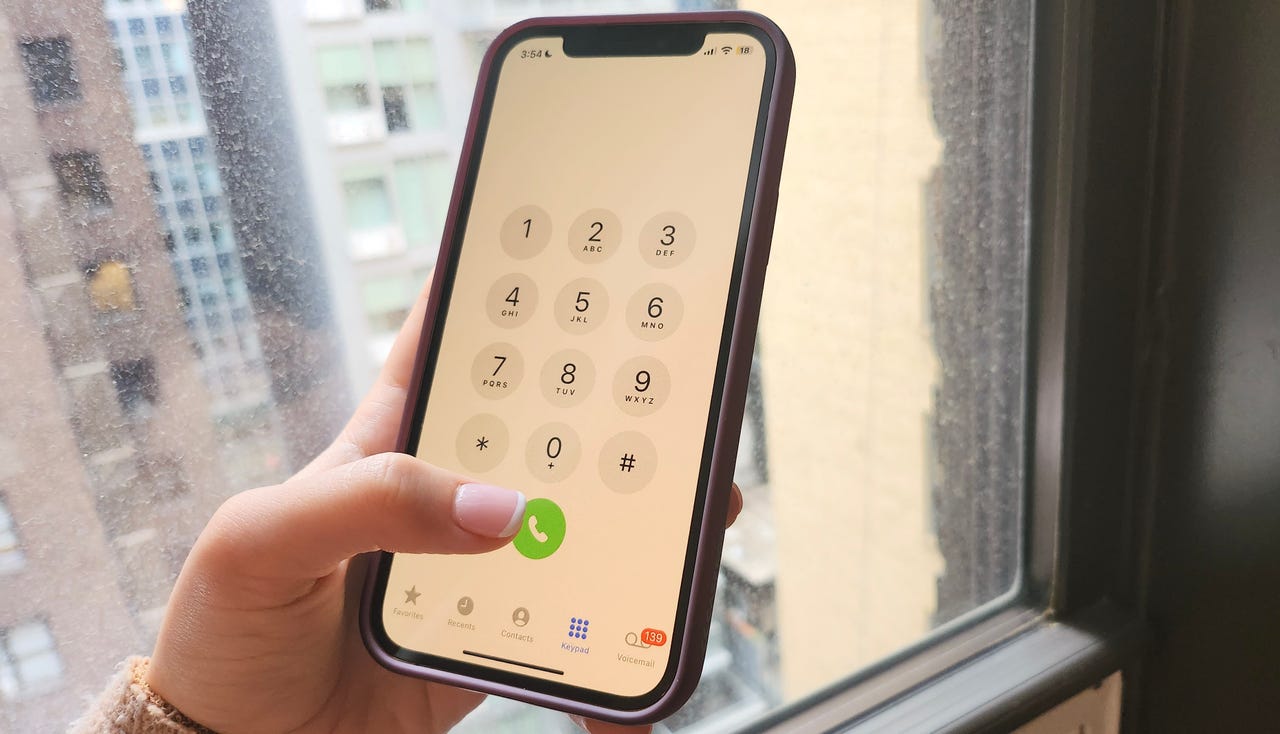'ZDNET Recommends': What exactly does it mean?
ZDNET's recommendations are based on many hours of testing, research, and comparison shopping. We gather data from the best available sources, including vendor and retailer listings as well as other relevant and independent reviews sites. And we pore over customer reviews to find out what matters to real people who already own and use the products and services we’re assessing.
When you click through from our site to a retailer and buy a product or service, we may earn affiliate commissions. This helps support our work, but does not affect what we cover or how, and it does not affect the price you pay. Neither ZDNET nor the author are compensated for these independent reviews. Indeed, we follow strict guidelines that ensure our editorial content is never influenced by advertisers.
ZDNET's editorial team writes on behalf of you, our reader. Our goal is to deliver the most accurate information and the most knowledgeable advice possible in order to help you make smarter buying decisions on tech gear and a wide array of products and services. Our editors thoroughly review and fact-check every article to ensure that our content meets the highest standards. If we have made an error or published misleading information, we will correct or clarify the article. If you see inaccuracies in our content, please report the mistake via this form.
How to record a call on your iPhone (and check if it's legal in your state)

Whether you're conducting interviews, doing research, or otherwise need to document a conversation, there are many reasons you may want to record a phone call on your iPhone -- but so few ways to do it.
For privacy reasons -- and due to laws that vary by state -- Apple does not allow recording through the iPhone's built-in microphone while the phone is actively on a call. Put simply, you can't hit "record" while you're talking on the phone.
Also: The best iPhone models you can buy right now (including the iPhone 15)
It's reassuring that Apple prioritizes customer privacy; however, sometimes recording a call is necessary. Here are a few ways to make it happen, both with and without the use of third-party apps.
Before you record a phone call from your iPhone, keep these things in mind:
- Always check that recording is legal. States have varying laws regarding recording phone calls. You can check your state's policy here.
- To record, you will need either an external iOS device with audio recording and microphone functions or a third-party app with separate call software like Google Voice. Third-party apps may require a subscription fee.
- The first method below is considered the most accessible for most iPhone users who want to record a conversation -- especially if they want to be subtle about it.
How to record a phone call on iPhone
What you need:
- One iPhone to host the call, which we recommend putting on speakerphone
- Another recording device (this could be another iPhone, an iPad, or even an Android device) using Voice Memos or another recording app to record the call
1. Test your Voice Memos app
First, make sure you have both an iPhone and another iOS device, such as a Mac, iPad or another iPhone, that includes the Voice Memos app. The Voice Memos app comes preinstalled on most devices, but it is also free on the App Store. If using an Android device, check that it has a recording app, like this free one.
Also: iPhone 16: Three changes I want to see on the next Apple handsets
Open the Voice Memos app, tap the red record button, and start speaking for long enough that you can ensure the sound quality is adequate for recording a conversation. When you are done recording, press the red button again. An audio file will appear called "New Recording (number correlating to the voice recordings you have)." If you have Location Services turned on, the recording will be titled with the address of your location instead.
Voice recordings autosave under different names based on whether Location Services are turned on.
2. Play back the audio file and make adjustments
Now, play the file back and see if the audio is discernible. Make the adjustments you need before you record a phone call.
Also: How to clear the cache on your iPhone (and why you should)
For example, if the sound quality is too low, you may need to speak louder, increase the microphone sensitivity (go to Settings > Sounds & Haptics), or put the speaker closer to your mouth.
3. Check whether you need to inform the other party that you're recording
Always check if the state you're recording and residing in is a one-party or all-party state when it comes to recording consent.
Also: Get a 4 pack of Apple AirTags for $80 and track all your essential items
One-party states require only one person on the call -- which would be you -- to consent. An all-party state requires both the person recording and the person(s) being recorded to consent.
4. Start recording
After disclosing that you're recording or -- if necessary -- getting permission to record, set up the second device so that Voice Memos (or the other app you're using) is ready to record. Put the device near the phone making the call and hit the red button again to record.
Start the recording before you start the call -- this may add a few seconds of silence to the audio file, but will ensure you don't miss any of the conversation. On your iPhone, make sure to initiate the phone call on speakerphone.
Once on the call, you can improve your audio quality by swiping down on your screen's upper right side to get to the Control Center. Select Mic Mode > Voice Isolation.
Pro tip: The red lines on the sound graphic, known as a waveform, indicate how well the app is picking up sound. The higher the bars are, the higher the volume that's detected. If the waveform stays flat, you may need to turn up the phone call volume or move the devices closer together.
Changing Mic Mode once a call is active.
Spikes in the red waveform bar indicate a louder sound -- when it's flatter, it indicates lower volume. If your waveform looks low as you record, you may have to move closer to the phone for Voice Memos to pick up a more accurate sound.
5. End the recording and transfer the file
When the conversation is over or you've gotten the information you needed, end the recording by tapping the red button.
Also: Apple to allow used parts for some iPhone repairs
From within the Voice Memos app, select the file of the recording and tap the ellipses button (three dots) to the right of the recording name to bring up share options. You can send it directly to your iPhone via iMessage or other messaging apps, mail, AirDrop, Slack, or even Google Drive.
Open up sharing options. You can also trim or rename the recording to something easier to remember by clicking Edit Recording.
Other ways to record
Following the steps above is the easiest, most efficient, and most discreet way to record a phone call on your iPhone. If you or a trusted second party don't have another device to spare, here are a few alternatives.
Note: Many apps that record phone calls likely need to conference into the call before recording begins, which may take a moment and could be detectable by the other person on the call.
Rev Voice Recorder
Rev has a few options depending on what you need. If you want to record phone calls, try their Call Recorder app -- it's free, with no limits on recording lengths, and even has in-app legal guidance. For recording other conversations, Rev's Voice Recorder app is also free and has an easy-to-use interface.
Plus, Rev offers AI-supported transcription of your recordings for $0.25 per minute, or you can have a human professionally transcribe your recording for $1.50 per minute. Once you download your file, it will appear as an MP3 file on your device. This is a great option for recording phone calls and narrating screen recordings.
Google Voice
The Google Voice app for iOS lets you make free and recorded calls using Wi-Fi via Google Voice. If you have a personal Google account, you can only record incoming calls, and they must come to your Google Voice number. If you have a Google Workspace account through work or school, you'll have more recording capabilities, but you'll need to obtain the proper Google Voice license.
You can select the device from which you want to initiate a call via the app. For incoming calls, you can go to Settings > Calls > Incoming call options and then toggle the incoming calls record option.
Once everyone is on the call, press the number four (4) on the keypad to start and end the recording. The call will end up in the record menu option after it ends.
Easy Voice Recorder
Easy Voice Recorder is another free app that allows you to record high-quality voice memos or recordings to PCM, MP4, or ACC files -- all of which can then be saved to your iCloud account. It can't record phone calls hosted by the same device, but it does have quick and easy built-in transcription capability for no extra cost.
As the name suggests, this app is designed for users to be able to whip out their phones and start recording whenever, wherever. If you download the app and use it on an iPad to record, you can also drag and drop recordings with the Files or other recording apps for further transcriptions -- or simply to consolidate recordings.
FAQs
Is it illegal to record phone calls?
Federal law requires at least one party's consent, which means that you need to be part of the conversation you're recording or have the consent of at least one person in that conversation. Otherwise, it can be construed as wiretapping or illegal eavesdropping. Some states have even stricter laws that require the consent of all people involved in the conversation.
Before recording a conversation, check your state laws.
Is there an app to record calls on iPhone?
Several downloadable third-party apps can record calls on the iPhone, but that capability is not built into the device itself. However, Apple is restrictive about letting these apps use the microphone during a phone call. Most apps will need to conference into the call as a participant to record. Beyond the method outlined above using the Voice Memos app, people also use Google Voice, Easy Voice Recorder, and Rev.
Also: How to buy more iPhone storage
Alternatively, you can use most mic-equipped computers or tablets to record phone conversations, as long as the phone is on speaker or the microphone is held close to the other device's speaker. Both MacOS and Windows computers have numerous audio recording software options available.
Does Apple have an app to record iPhone calls?
Unfortunately, no -- at least not yet. Apple itself doesn't have an app, but there are third-party apps available on the App Store. Also, Voice Memos is most likely automatically installed on your iOS device.
Does screen recording on iPhone record my call?
Screen recording while on an audio or FaceTime call will only record your screen -- it won't capture any audio from you or your phone.
Also: How to get water out of your iPhone speaker fast
Does iPhone's Voice Memos have a time limit?
The Voice Memos app can record for an unlimited amount of time as long as you have sufficient storage availability. To check how much storage is on your device, go to your iPhone's Settings > General > Device > Storage. You can also buy more iPhone storage.
